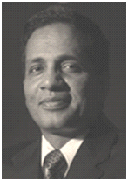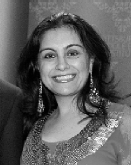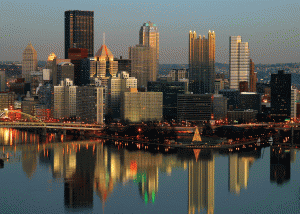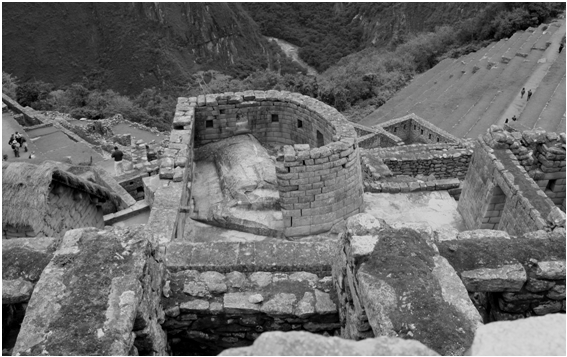Archive for February, 2010
Traveling in the Sacred Valley of the Incas
Posted by admin in January 2010, Travel on February 23, 2010
By Padma and Raman Venkataramanan,
Pittsburgh, PA
E-mail Padma
In a previous issue we had discussed our trip to Peru. After visiting Lima the capital of Peru we went to Cusco, the original capital of the Incan empire and the gateway to many Inca ruins. After enjoying the city of Cusco and the nearby ruins, we visited a few small towns near Cusco before our trip to Machu Picchu.
Sacred valley of the Incas: The “Sacred valley of the Incas” (The Urubamba valley), has beautiful stretches of small villages (Pisac, Urubamba, Ollantaytambo and Chinchero, to name a few), and ancient ruins spread across the mountain slopes. The Urubamba river had made this valley a fertile agricultural center for the Incas, who grew white corn, coca, potatoes, peaches and avocados. The agricultural sector extended well into the spectacular terraced mountain slopes. In Pisac, we saw a large fortress complex built by Incas high up on a cliff . See the picture below. Here you also see one of the largest burial sites of the Incas. The artisan and antique market in the central square in Pisac is famous for sweaters, ponchos, tapestries, rugs, musical instruments, and carved gourds.
Ollantaytambo is a beautiful village with streets dating from the Incan times. The streets are lined with brick walls and in the middle one can see the canals carrying water from the mountains. One can also see terraced ruins of a massive temple fortress built by the Incas and the agricultural terraces. On the mountain side there are granaries built by the Incas and the carved faces of the Incas can be seen on the cliff. In Ollantaytambo, we were fortunate to see a residential canchas or blocks built and inhabited in the 15th century. Each block contained a set of three houses that open into a court yard and in the center was the common storage area. Each of the houses essentially consisted of a huge room with a prayer table set at one end (the skulls from the ancestors were kept here to protect the inhabitants); the beds lining up the wall on the other end; and the kitchen area in one corner. Guinea pigs were running around in one side (but they seem to know their limit), and the local Peruvian ladies were busy with their handicraft work on the other side. See the picture below. There is also a second level storage area inside this room right above the beds. It was interesting to see how efficiently they had used the small room for so many activities for the entire family. Leaving Ollantaytambo, we get a gorgeous view of the snow capped mountain ranges of Urumba, Salcantay, and Vilcabamba, near the town of Chinchero.
Machu Picchu (the lost city of Incas): Now it was time to visit Machu Picchu. Machu Picchu is the lost city of Incas. The Incas built it so high up in the mountain that it escaped destruction by the Spaniards who occupied Peru. Machu Picchu was rediscovered in 1911 by the Yale archeologist and historian, Hiram Bingham. Hiram, who was actually looking for Villacabamba, the last refuge of the Inca, Monga and his army, came to know about the ruins in Machu Pichu from a local farmer, Melchor Arteaga. Melchor and two local Indians Richarte and Alvarez directed him to the ruins in Machu Pichu. It was Hiram and his companion Sergeant Carrasco who first set eyes on these extraordinary ruins in July 1911.
One can hike for four days, about 33 kilometers, on a rugged path to Machu Picchu from near the village of Ollantaytambo, or take a train from Cusco to the town of Aguas Calientes, at the base of Machu Pichu. We took the vista dome train from Cusco early one morning and reached Aguas Calientes around 10 am. The scenery on the way was just impressive. Aguas Calientes is a small tourist trade town, known for its thermal baths. After lunch and some rest at the Inca Inn, we walked along the Urumba river and visited a museum on Machu Picchu (a good place to get some orientation to the place), and then a botanical garden (to see the local plants and shrubs). We walked through the local shops, checking out the colorful local goods. See below.
The next morning we took a bus to Machu Picchu. Machu Picchu means “old peak.” The city of Machu Picchu sits atop a mountain well above the Urumba river, and is surrounded by breath-takingly beautiful peaks, all covered with the mist from the Urubamba river down below. It was like magic; it was a spectacular archeological site.Hayana Picchu (young peak) sets up a dramatic backdrop to Machu Picchu. We decided to climb up Huayana Picchu. We hadn’t planned on it, but couldn’t resist the once-in-a-life-time opportunity. The climb was quite steep at some places. As we climbed this mountain, the cloud cover slowly lifted up and as we reached near the top, we could see the stunning piece of Incan architecture down below. (See the picture on the front cover). The ruins of Machu Picchu were nestled in the mountain top surrounded by several mountains and the Urubamba river in the valley in between. It was just spectacular. It is a place of mystery and magic. Nobody knows exactly what it was built for – was it a citadel, an agricultural site or an astronomical observatory? A ceremonial city or a scared retreat for the Incas? Or a combination of all these? No matter what it was originally meant for, it is just awesome. No photograph can do justice to the beauty of this place. You have got to be there to enjoy/feel it. We were glad we claimed Huayana Picchu and take in this spectacular view.
We then walked down to the city of Machu Picchu. By now the place was filled with tourists; we were glad that we got there early in the morning to enjoy the place from Huayana Picchu in peace and quiet. The city landscape was broadly divided into lower and upper industrial section and lower and upper agricultural section. We first walked into the agricultural sector; then went past the dry moat into the city itself. Then walked right into the fountains (small waterfalls, actually), then went through the Temple of the Sun; Temple of the Moon; Temple of three windows; Temple of the Condor; the Quarry; and the Royal tomb. Steep terraces, gardens and lime stone temples and aqua ducts that have all been carved out of the hill side. One cannot escape asking the question ‘How did they do it? How did they find such a place to build this?” It was a treat. No where have we seen such a combination of natural beauty and the pioneering spirit of human being merge in one place as it does here in Machu Pichu. After taking it all in, we took the bus down to Aguas Calends, and then the train back to Cusco. Got to Cusco around 7 pm, fully contented and thankful for this unique and wonderful opportunity.
No wonder UNESCO has classified Machu Picchu as a heritage site. It is the eighth wonder of the world.
Suggestions if you plant to visit:
Flight: Fly from Pittsburgh to Atlanta or Ft. Lauderdale to Lima to Cusco to Machu Picchu. Duration of trip: Plan for a week’s trip.
Need three days in Cusco – get acclimatized to the altitude and do local sites (Cusco, the sacred valley of the Incas)
Need two days in Aqua Calientis and Machu Picchu – spend a whole day in Machu Picchu; start early in the morning from Aqua Calientis.
Need two days in Lima – local sites
Food: Vegetarians, pack some food with you.
Time to go: May through October
Temples Need to Attract Our Own Gen-X
Posted by admin in January 2010 on February 23, 2010
by Lakshmanan Krishnamurti,
Pittsburgh, PA
Email Lakshmanan
 Lakshmanan Krishnamurti was born in the temple town of Madurai, India. He has lived in many places in India, first as the son of an Indian Air Force officer and then as a physician in the Indian Air Force. He moved to the US in 1993. He is currently a physician specializing in blood diseases, cancer and bone marrow transplantation in children.
Lakshmanan Krishnamurti was born in the temple town of Madurai, India. He has lived in many places in India, first as the son of an Indian Air Force officer and then as a physician in the Indian Air Force. He moved to the US in 1993. He is currently a physician specializing in blood diseases, cancer and bone marrow transplantation in children.
The article by Sridevi Rao James in the last issue raises important questions on how to sustain Hindu institutions in the United States. Rao James observes that as the first generation of founding Hindus slowly fades away, the mantle of leadership will have to pass to the next generation born and raised in the US. At first glance, this appears to be an obvious an inevitable change. However, public institutions are living organisms with a natural life cycle of growth, maturation, stagnation, even decay. They can also change course according to the people who participate and run these institutions. The composition of the worshippers and leadership of religious institutions set up by immigrant communities in the US will change over time. Many may even cease to function as the founding members of their congregation age and eventually fade away.
Ms. Rao James says, depending on only new Indian immigrants to take care of the temples is not only shortsighted but also likely to further alienate the already disengaged Hindu Indian-Americans born and raised here. The alienation of US born Indian-Americans from Indian immigrant students and their institutions is evident on university campuses. However, there is a distinction between college students who may be still grappling with their own identity and their need to fit in and adults who are trying to raise children in their own cultural traditions.
In Hindu temples across America, Indian immigrants, US-born Indian children and adults, American spouses, interracial children and some children and adults with no Indian heritage at all, all worship and participate in the various classes and activities, motivated by their interest in the Hindu tradition. That these individuals with diverse backgrounds are able to participate in the activities of the temple indicates that these institutions not only welcome people from different backgrounds, but also accept the attitudes and values people from diverse backgrounds.
If US-born Hindus overcome their reservations and become involved in these institutions, they will fit in very well..
There are however, many challenges that we face to make our institutions relevant and attractive to our young people. Attendance of children in Temples drops off after 10th grade though some young college students continue to attend. Hindu temples in the US are thriving largely because of the dedication of the large number of recent immigrants and the organic link they provide to India. However, the seemingly unending supply of immigrants from India is subject to change by social, political and economic forces.
While many Indian immigrants view their institutions through the prism of caste, region, language, and social mores as they existed at the time of their emigration from India, others are completely turned off by these.
For too many immigrants, the temple is merely a salve against social isolation and a means to get the acceptance they seek, but do not seem to get elsewhere.
As the new immigrants have struggled to adapt to the American mainstream, a whole generation of American-born Hindus have come of age. They take for granted the fruits of the struggles of their parents. Besides, youngsters, often pushed by their families to excel in school and at work, have had neither the time nor the opportunity to acquire more than a superficial familiarity with their culture and religion.
Many living in biracial and two-religion households may find the institutions of the non-Hindu/Indian half of their families more welcoming.
US-born Hindus may be different from their Indian born parents, but that does not make them less deserving of celebrating their religion, culture, and heritage. We ignore this shift in the demographics at the peril of losing the long-term viability of our institutions.
How do we attract and retain the interest of this generation? The
answer is astonishingly simple. We, who are rediscovering Hinduism in America, need to restore temples from their recent role as mere places of worship, to their traditional place as centers of social and cultural life of our communities. This holds the possibility that American-born Hindus will be drawn to these places during the different transitions in their lives. We must also actively recruit US born Hindus of every age to our temples, trust them, and give them responsibility of running it.
Like Rao James, I too believe it is time to be creative and thoughtful about how to bring our youth back into the fold. Otherwise, Hindu temples all across the US built with love by a whole generation of immigrants may survive only as museums.
Editor’s Note: We thank all the authors who came forward to share their thoughts and ideas on this thread of topic. This topic, we hear, has triggered lot of table-topic discussions in many homes and gatherings of our readers.
Fareed Zakaria at Carnegie Hall
Posted by admin in January 2010 on February 23, 2010
By Nita Wadhwani,
Pittsburgh, PA
Email Nita
 Fareed Zakaria, in his keynote address delivered at the Carnegie Hall last fall, said, “It is now a new Middle East,” and “The Persian Gulf states represent the future of the Middle East more so than countries like Egypt and Syria.”
Fareed Zakaria, in his keynote address delivered at the Carnegie Hall last fall, said, “It is now a new Middle East,” and “The Persian Gulf states represent the future of the Middle East more so than countries like Egypt and Syria.”
He was in Pittsburgh last October at the invitation of the Pittsburgh Middle East Institute (P.M.E.I) to talk on “The Real Solution to the Middle East Crisis” His speech at the Carnegie Music Hall on October 13, 2009.
Fareed Zakaria hosts CNN’s international affairs program Fareed Zakaria GPS on Sundays that is telecast worldwide. He writes a weekly column for Newsweek and has written several books including The Future of Freedom, a New York Times best seller. His most recent book, The Post American World, is an instant best seller. Born and raised in India, Zakaria, now 45, was the managing editor of Foreign Affairs when he was barely 28.
Introduced by Paul O’Neal, the Secretary of Treasury for George W. Bush, Zakaria delivered an engaging insightful speech sprinkling it with humor. He started the evening with his assessment on the current economic situation: “We are not living in a workers’ paradise” and “the world will never be the same again.”
Zakaria felt that since 1979 there are fewer political conflicts in the world. He said places in the Middle East have linked modernity to education, citing Dubai as an example:

L to R: Sayyid Badr Al Busaidi, Lyutha Al Mughairy, officials from the Sultanate of Oman, Fareed Zakaria, Hunainah Al Mughairy, Oman’s ambassador to the US, and Simin Yazdgerdi Curtis, Founder-Presi-dent of P.M.E.I. in the meeting.
“There is plenty of money in the Middle East, and rulers there are trying to link it to education,” persuading internationally recognized education institutions “such as Carnegie Mellon Institute and other schools to open their branches in the area.”
The Middle East has prospered with diversity, he said. “The money coming from Persian Gulf is changing the world. The power of capitalism has transformed the area. … … The Persian Gulf states represent the future of the Middle East more so than countries like Egypt and Syria,” said Zakaria.
He touched on sensitive topics like Iran and Pakistan with reference to US foreign policy priorities and objectives. The biggest strategic challenge for the US would be its relationship with China, he said. He was optimistic that it would be managed well by their leaders.
This is understandable. After all, we in the US can sustain our lifestyle only with cheaper imports from China. This has led to huge trade deficit with China. And China is also financing our debt. But China’s global economic, political and military ambitions do not align with the foreign policy objectives of the US.
Discussing Pakistan’s role as a challenge for peace in the Persian Gulf area, Zakaria said, the Persian Gulf’s regimes are aware that many attacks in their area have originated from Pakistan. The regimes there are dealing with the rise of the Islamic fundamentalism in the region.
The evening ended with some questions and answers. Zakaria was candid and humorous in his responses:
Q: How would you rate Secretary Clinton’s first year as Secretary of State?
A: When the president himself is engaged in foreign affairs, it limits the role of the Secretary of State.
Q: Can Iran negotiate in good faith?
A: Yes even though it is a rigid theocracy. But it will not negotiate its nuclear policy. It is surrounded by neighbors with nuclear weapons.
The evening ended with Zakaria receiving a Steelers jersey.
The evening was organized under the aegis of the Pittsburgh Middle East Institute (P.M.E.I), an independent, nonprofit organization dedicated to promoting educational and cultural partnerships between Pittsburgh and the countries of the Middle East. This was their 2nd annual meeting.
Pittsburgh Needs a Regional Solution
Posted by admin in January 2010 on February 23, 2010
By Kollengode S. Venkataraman
 Recently, Pittsburgh Mayor Luke Ravenstahl’s proposal for a 1% tax on college tuition drew a lot of flak. Obviously, nobody likes taxes. As with many fiscal problems the nation is mired in, the fiscal problems of Pittsburgh have been growing for over two decades since the decline of the steel in the 1970s. All elected officials were only too aware of them.
Recently, Pittsburgh Mayor Luke Ravenstahl’s proposal for a 1% tax on college tuition drew a lot of flak. Obviously, nobody likes taxes. As with many fiscal problems the nation is mired in, the fiscal problems of Pittsburgh have been growing for over two decades since the decline of the steel in the 1970s. All elected officials were only too aware of them.
In many parts of the nation, during the years when oil was aplenty and inexpensive, the suburbs grew at the expense of the cities. There were also strong underlying social trends contributing to this: School busing, high crime rates in inner cities, and housing integration all contributed to what sociologists called the White Flight in which suburbs grew at the expense of cities. The graph below encapsulates this trend in our region.
The data for this plot were taken from http://www.spcregion.org,the website for the Southwestern Pennsylvania Commission, the forum for collaboration and public decision making. This forum comprising of elected officials from the ten counties around Allegheny County also has state and federal government officials. The other source for the data is of course the US Census Bureau. The following numbers are worth extracting from the plot.
We see that Pittsburgh’s population has disproportionately decreased from its peak when compared with the population declines in the region.
Secondly, nonprofit organizations — educational institutions, hospitals, places of worship, museums, recreational facilities, and many, many others — occupy a large chunk of real estate in town. The tax-exempt nonprofits, as elected officials have stressed, considerably reduce the city’s tax base.
To add to the city’s woes, a large number of suburbanites- estimated to be the entire population of the city – descend onto the city or drive through the city every day for work, recreation, and transacting business. This many number of people coming to the city every day drains a lot of city’s resources. The mayor simply can not pile more tax on city’s shrinking number of residents to fill the gap.
Yes, the city’s financial problems have been festering for a long time. But the tax-exempt nonprofits are not on moral high ground when they complain about the mayor’s 1% tax proposal on tuition.
The entire healthcare industry has been raising their charges on patients every year. Colleges and universities too have been continually raising their tuition to students. And the supposedly nonprofit UPMC makes obscene profits and has a huge and arguably aggressive presence in town.
The decline of steel in the 1970s devastated the entire region, and USAirways shutting down its hub at the Pittsburgh airport financially ruined the airport. So, we can argue that UPMC’s increasingly dominant presence may not be good for the city or for the healthcare industry in the region in the long run. Besides, the nonprofits are not living on shoestring budgets. The profligate management styles of the nonprofits and the salaries of their executives make one wonder if we need to change the definition of nonprofits for tax purposes. See Sally Kalson’s article UPMC: at odds with itself (www.post-gazette.com/pg/07140/787267-149.stm).
There are other solutions to the region’s problems. One is consolidating the 120-plus municipalities in Allegheny County into a SINGLE municipality. But given local politics and the refusal of the affluent neighborhoods to shoulder the region’s problems — even though they fully exploit and benefit from the city’s resources — we can as well wait for the Second Coming.
I’ve called Luke Ravenstahl “Fluke” Ravenstahl because he became the mayor by accident when Mayor Bob O’Conner suddenly died. Obviously, this epithet is misplaced because the mayor is expected to solve Pittsburgh’s huge financial mess. If anybody has a viable, equitable alternative to bridge the $15 million hole in the city’s budget, give him a call. He is all ears.

